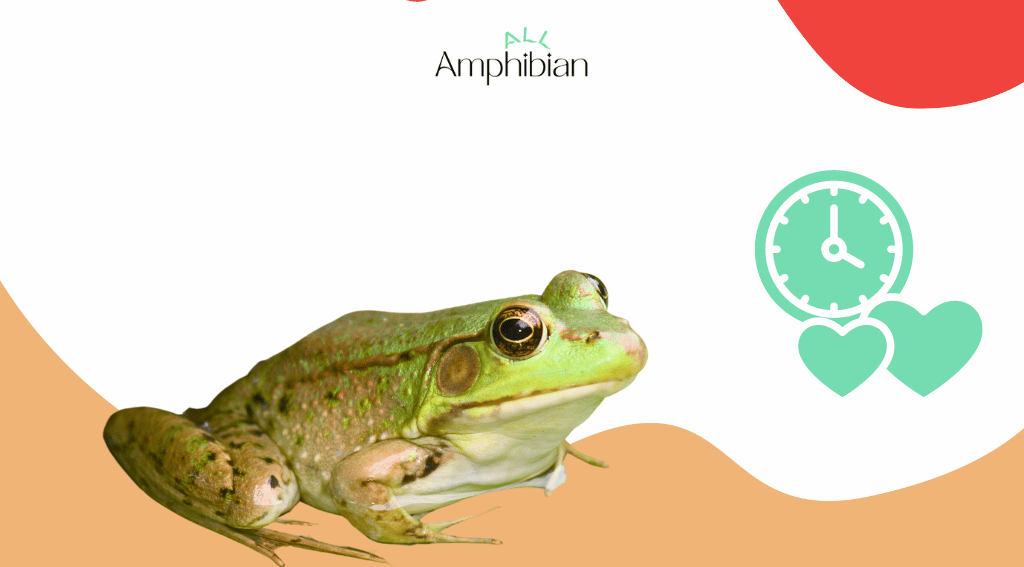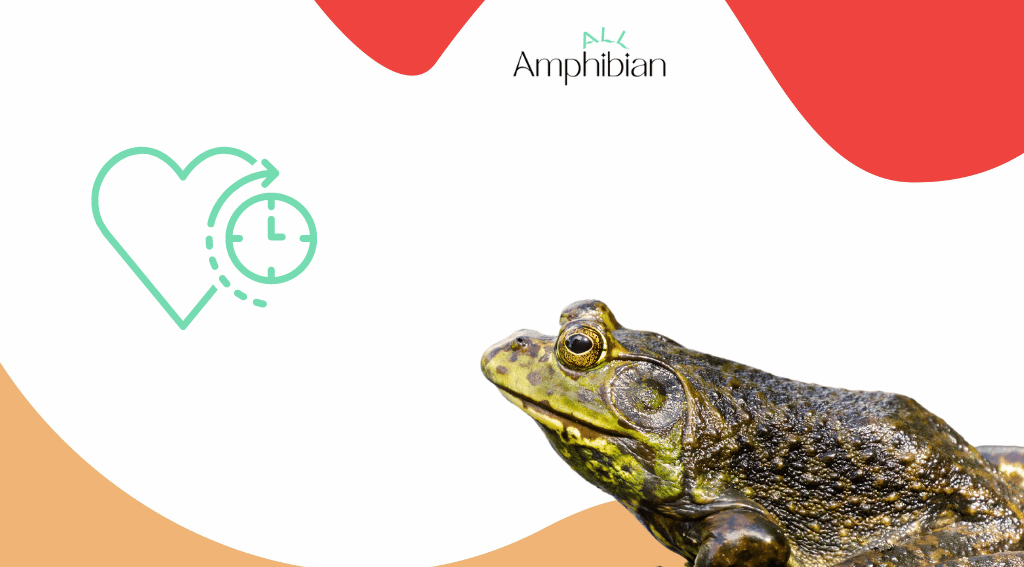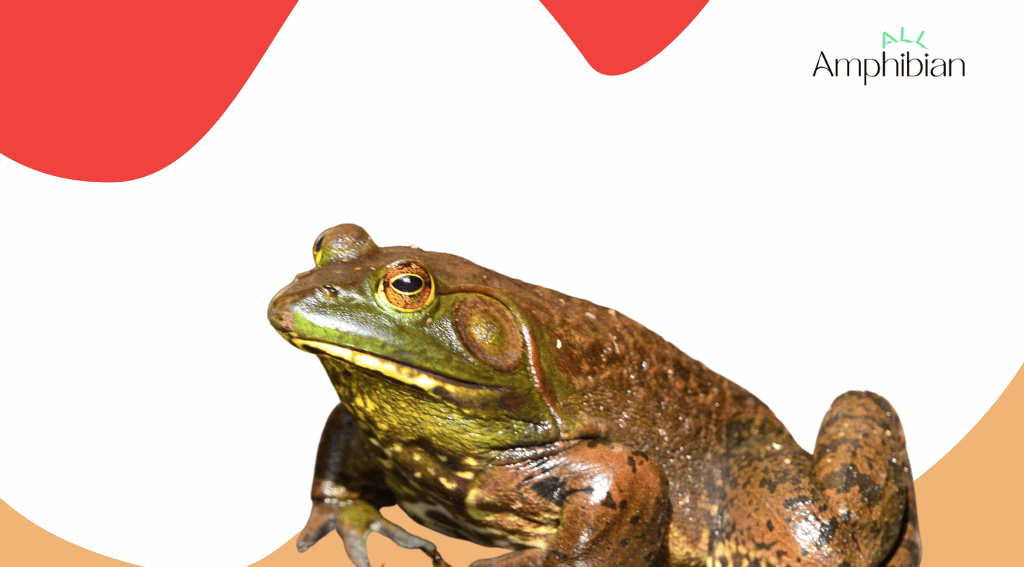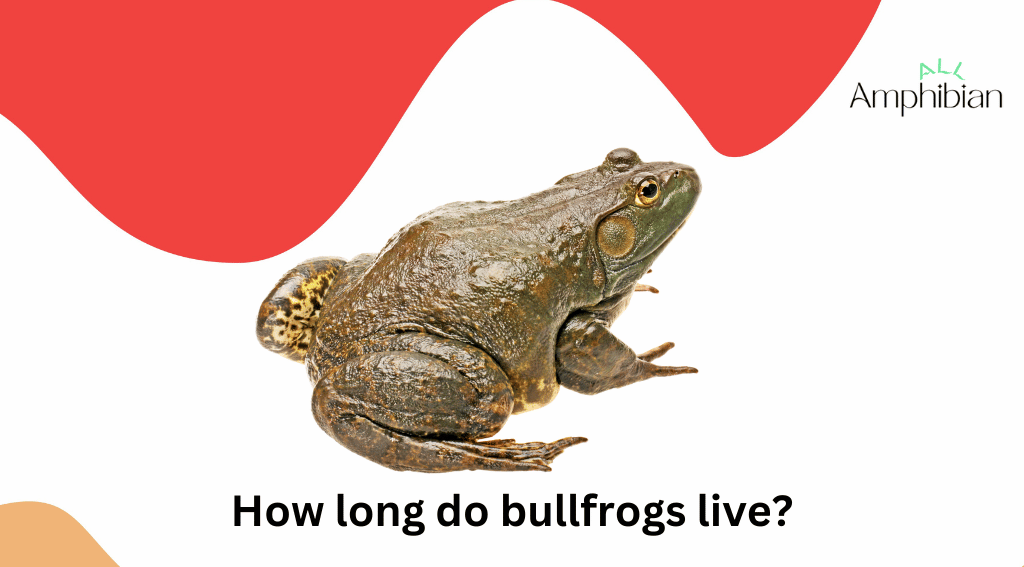How long do bullfrogs live? Bullfrogs are a famous species of frogs that most of us know because of their large size and strange sound. But do you know how long they live? Stay with us at All Amphibian to find the answer to this question.
How long do bullfrogs live?
The bullfrog is a type of frog that lives in North America and Canada. Bullfrogs are famous for their large size and their strange sound. In fact, because of the sound that the males make during the reproductive season, which is more like the bull’s sound, they named it bullfrog.
Many of us have seen them living in ponds or lakes and along rivers. Their choruses are very famous in America, and during the mating season, their singing can be heard everywhere and even annoys the residents of those areas.
Bullfrogs are carnivores and will eat anything they can fit in their mouths. Many people keep them as pets. Bullfrogs normally live between 7 and 9 years in the wild, but research has shown that their life expectancy in captivity is even longer. The average weight of bullfrogs is 500 grams, but even up to 800 grams have been reported. Their length is usually between 10 and 15 cm, but larger species can reach up to 20 cm.

How long does a bullfrog live as a tadpole?
Bullfrogs mate once a year. Their mating time is in spring. Usually, they mate later than other frogs and wait until the end of spring. During mating, males gather in certain areas and start singing together. This singing is to attract the attention of the female. The difference between male and female bullfrogs is their size. Males are usually larger.
The size of the tympanum is also larger than the eyes in males, and the tympanum is the same size as the eyes in females. The bullfrog usually releases about 20,000 frog eggs in the water. Many of them are hunted by other animals and fishes. The tadpoles hatch after a few days. At this time, they are herbivores and feed on algae and aquatic plants.
On average, one out of every five bullfrog tadpoles reaches puberty, and The rest of them are hunted by other animals. bullfrog tadpoles have gills. Their life as tadpoles lasts for three years, and then they metamorphose. Their legs appear and they lose their tails. Their lungs are formed, and they can get out of the water. The life span of bullfrogs as tadpoles is three years, and then they can live in the wild for seven years after reaching maturity. But their average lifespan is less and is between 5 and 8 years.
What factors affect a bullfrog’s life span?

In nature, bullfrogs are predators. They usually wait slowly for the prey to approach them and then catch the prey with a jump and use their sticky tongue. They eat everything they can fit in their mouths. Insects, vertebrates, snakes, fishes, amphibians, mouses, crickets, turtles, and even birds are bullfrog’s food. They also have enemies in nature that hunt them.
Most small bullfrogs are hunted in the wild, and the adults have fewer enemies. Factors such as proper diet, suitable environmental conditions, and natural predators and disease have a great impact on the average life of bullfrogs. Today, many of them are hunted by humans because frog legs are a popular food.
Also, many of them are used for analysis in schools and laboratories. The reduction of suitable environments for bullfrogs has forced them to live in urban environments, and this reduces their population and lifespan. This is the reason why the difference between the life span of bullfrogs in the wild and in captivity is so great.
Do bullfrogs live more in captivity?

Bullfrogs make good pets. Many people keep them in their homes. They are docile and harmless animals, and because of their long lifespan, they can be your pet for many years. As we said, many factors affect the lifespan of frogs. The right food is one of the most important factors.
If you feed bullfrogs a good diet, they live longer. A good diet of insects and other small creatures so that they get all the nutrients they need. Bullfrogs are known for their large appetites and greed for food. Also, the right living environment affects their lifespan. To keep bullfrogs, you should always provide them with a shallow pond of clean water so that they can swim and stay moist.
You should change the water regularly so that they always have clean water. Also, they should have space to walk with some grass. Give BullFrog places to hide. All these create good environmental conditions for bullfrogs. They have a much longer lifespan in the right conditions and away from disease. In captivity, bullfrogs can live up to 16 years. The oldest Gauner frog in captivity is reported to be 20 years old. By creating suitable conditions for Govner’s frog, you can keep him for many years.
Do bullfrogs affect the population of other animals?
Bullfrogs are considered an invasive species in some areas. They reproduce quickly due to their high production power and longevity. The increase in their population due to their large appetite reduces the population of insects and small animals that hunt them. For this reason, the frog is known as an invasive species.
They are native to North America, but due to reasons such as:
- releasing them by their owners.
- breeding them for restaurants and escaping some of them into the wild
- releasing them in some areas for pest control.
Today they are also found in parts of Europe and Asia.

conclusion
The bullfrog is a species of frog that is famous for its large size and strange sound. They live in most parts of North America and Canada. Their habitat is near rivers and freshwater lakes. The reduction of their natural areas has caused many bullfrogs to move closer to urban areas to live.
Bullfrogs are carnivores and feed on insects, amphibians, snakes, mice, fish, amphibians, turtles, etc. They eat everything that fits in their mouths, and their greed is known for eating. The life span of bullfrogs in nature is between 7 and 10 years.
The first period of their life as tadpoles lasts three years. The female bullfrog releases about 20,000 eggs in the water, most of which become prey for other animals. Only one out of 5 bullfrog tadpoles reach adulthood. Factors such as suitable food and suitable environmental conditions for life and natural enemies and disease affect the lifespan of bullfrogs.
Bullfrogs live longer in captivity because they have better conditions and food. Their lifespan in captivity reaches up to 16 years. They make good pets and many people keep them as pets. The bullfrog is native to North America, but human factors have caused some of them to be seen in Europe and Asia today. Bullfrog is considered an invasive species that affects the reduction of the population of insects and animals it hunts.
FAQ
■ How long do bullfrogs live?
BullFrogs are a type of frog that are known for their large size and strange sound. They live around the rivers and lakes of North America and Canada. Their lifespan in the wild is between 7 and 10 years, but their lifespan is longer in captivity.
■ How long do bullfrogs live as tadpoles?
The female bullfrog lays about 20,000 eggs, but most of them are hunted by predators. Only one out of 5 bullfrog tadpoles reach adulthood. The life span of bullfrogs as tadpoles is three years and then they can live up to 7 years after puberty.
■ What factors affect the lifespan of bullfrogs?
Factors such as suitable food, suitable living conditions, the number of their enemies and predators, and disease are important factors that affect the lifespan of frogs.
■ Do bullfrogs live longer in captivity?
Yes, bullfrogs can live up to 16 years in captivity because they have good food and living environment in captivity and their natural enemies and diseases do not threaten their lives.
■ Are bullfrogs invasive?
Due to their high reproduction power and their great appetite, bullfrogs affect the reduction of the population of insects and animals they hunt and are known as invasive species.

